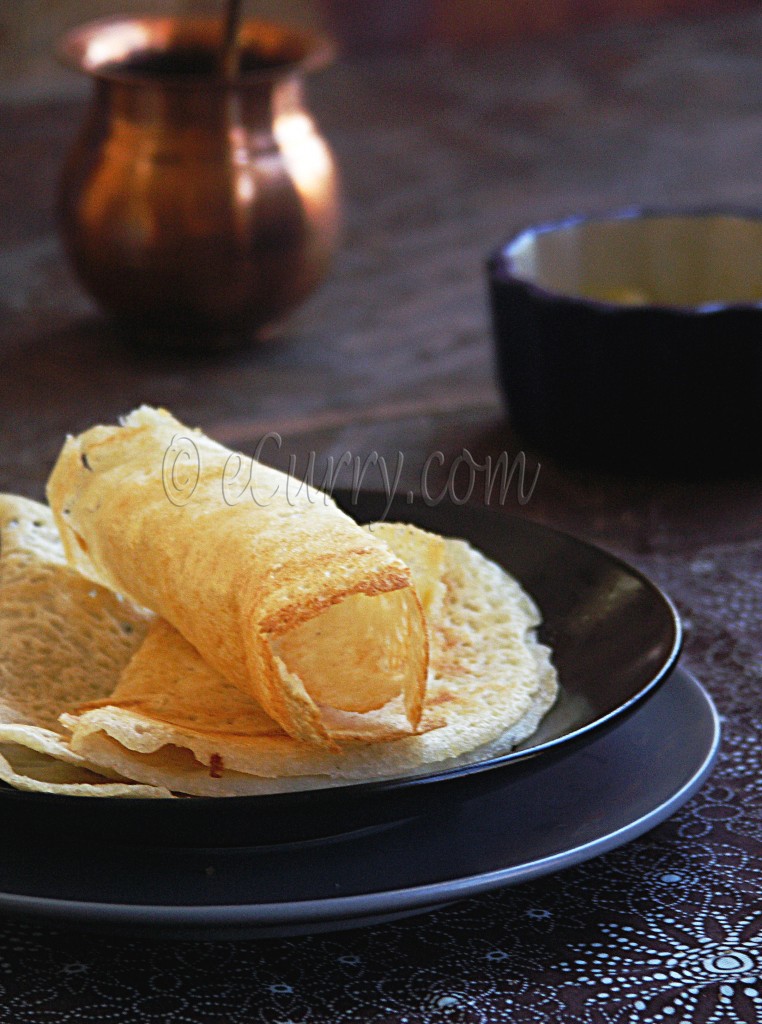
These paper thin savory crepes are enormously popular all over India. While Dosa is more of street food in the northern parts of India, they are almost staple and an everyday affair in the southern regions.
Dosa is a thin, delicate crepe like bread made from a fermented batter. The batter is usually made completely gluten free, with rice and lentils. There are however other varieties of Dosa which are made using different grains than rice. There is no leavening agent used. The batter ferments and rises as it rests for many hours in a particular temperature and is then cooked in a hot skillet/griddle to make crisp, thin crepes.
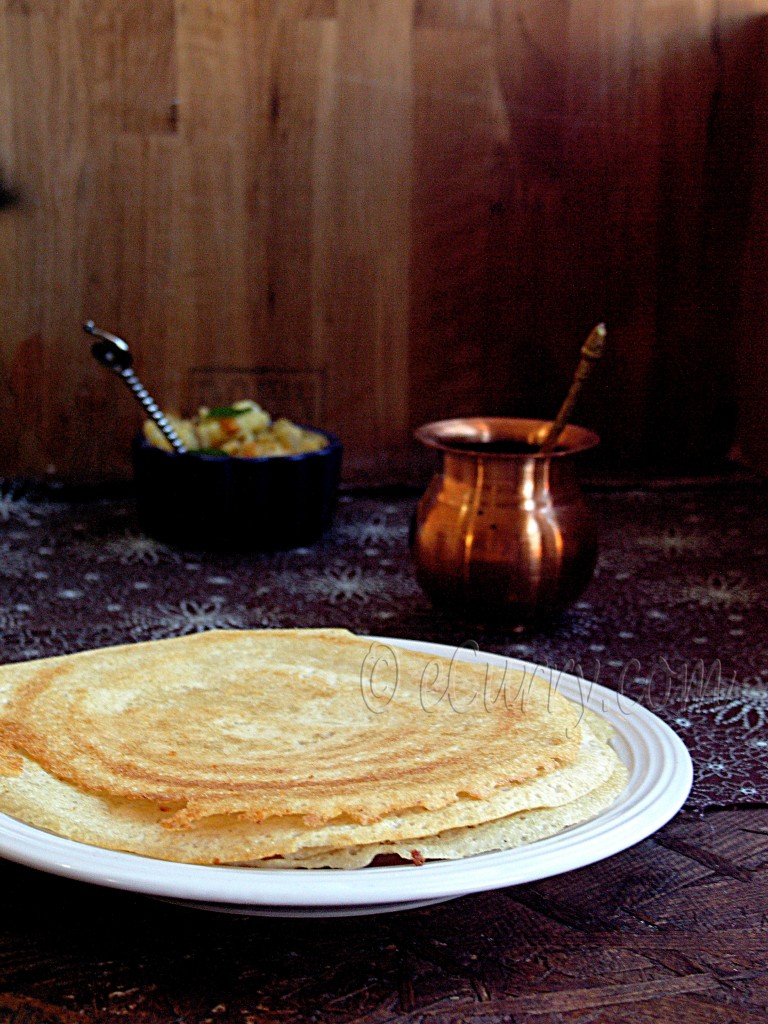
Growing up in the north eastern regions of India, I was first introduced to Dosa in a “south Indian” family friend’s home. Then came the time when we discovered that there exists a street vendor who actually walks around with his cart from one neighborhood to another making and selling hot “Paper Dosas“. The traditional Dosas differ quite a bit from the Paper Dosas as street food.
Shaped as it is below, it is called a Topi Dosa 🙂 (Topi = Hat). I found this out just recently, thanks to conversation in Facebook.
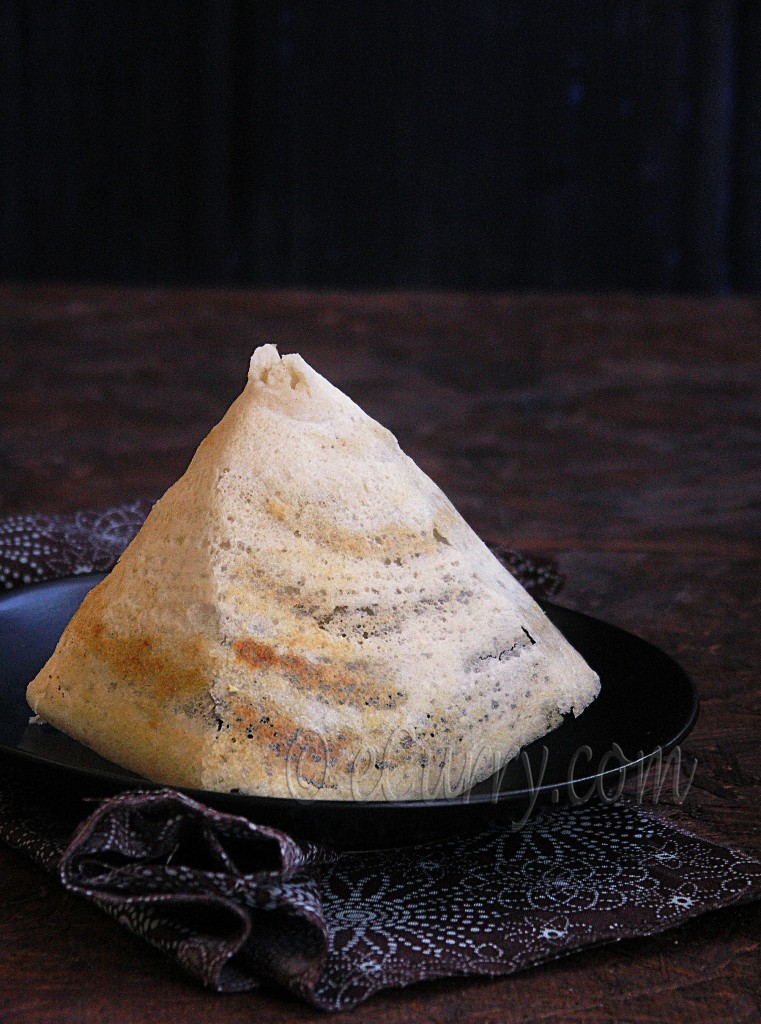
The cart would be well equipped with a stove, surrounded with stockpots filled with the batter, and a few more with Sambar (the lentil with vegetables that Dosa is usually served with) and two kinds of Chutneys. And the cart also had a bell; the ring of which rushed all of us in front of our home with money in one hand and a stainless plate with a couple of stainless steel bowls balanced on the plate on the other hand.
As the cart pulled near our gate, I would already have my few friends gathered around me, all of us looking forward to watch him make the Dosa and then take them home.
He pumped up his stove while we waited. The flame burst out, as he prepped the large iron griddle – smearing it with oil swirling the half onion on the knife end. Then he opened the lid of one stockpot, scooped out some batter with a ladle and poured it on the skillet. The loud “hiss” drew our attention once again to the cart. We stopped talking and drew closer to the cart, to see him make the swirly circles, the perfectly symmetric patterns with the flat bottom of a small stainless steel bowl. The Dosa would be ready in a couple of minutes – thin, light brown, with tiny little holes all over it.
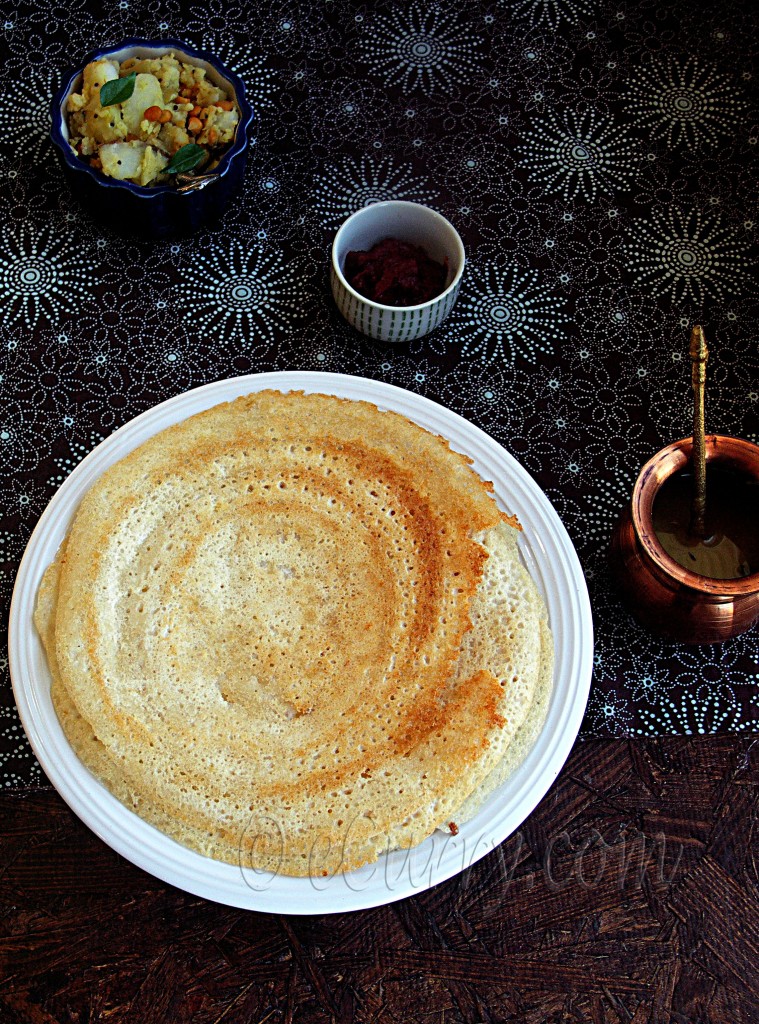
When I was little, the texture of the Dosa always reminded me of a sea shore; like the patterns that forms on the sand when the waves have ebbed away leaving the shore dry with minute pores; as if innumerable bubbles popped.
We took our turns, filled our plate with the Dosa (which always went over the edges of the plate ) and our bowls with sambar and the chutneys. The Dosa would have a scanty scoop of potato curry rolled in to it. With a filling, it is called a Masala Dosa. We always complained how stingy he would be with the filling. He smiled, but never never gave any more than he wanted to.

There wasn’t a plate big enough in our home to accommodate this longish paper thin crepe, rolled in like a tunnel.
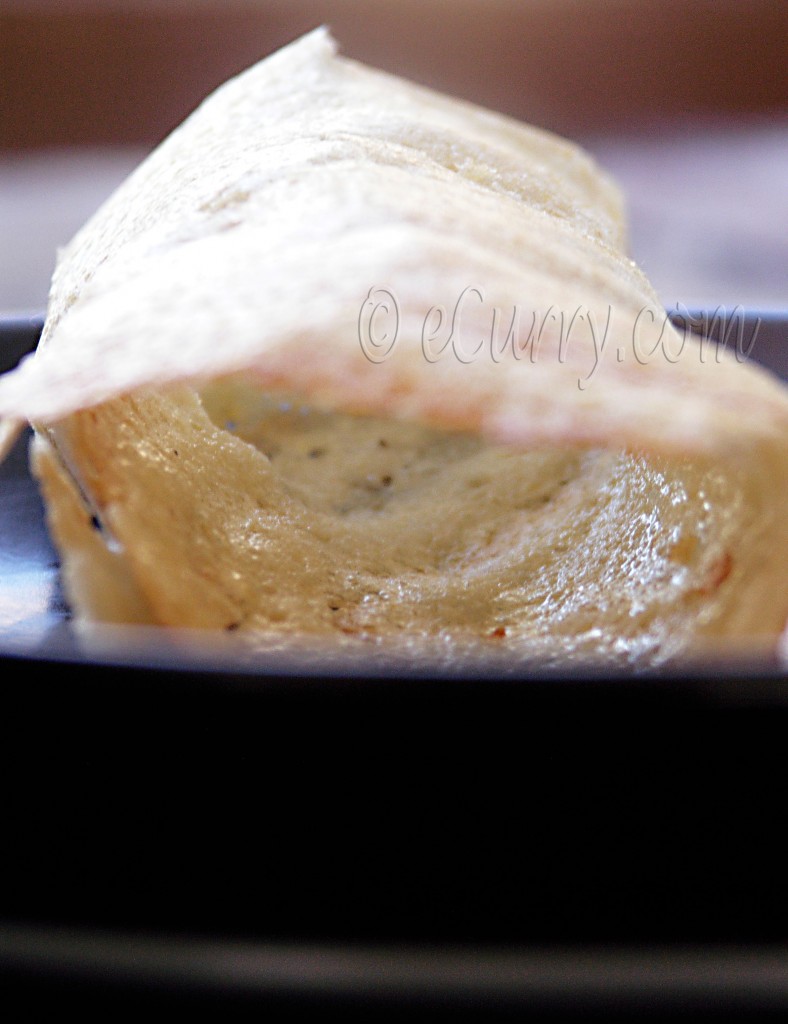
I am surprised that after so many years, I still remember every detail of the vendor; his curly crown, the occasional sparky grin (for he rarely smiled), his muscular arms and his every movement. I could probably recognize him even now; only now after more than fifteen years he would not look the same.
Then there were Dosas in the restaurants and only sometimes at home, which did not quite taste like the ones on the street. The size was smaller, and the sambar and the chutneys were just not the same.
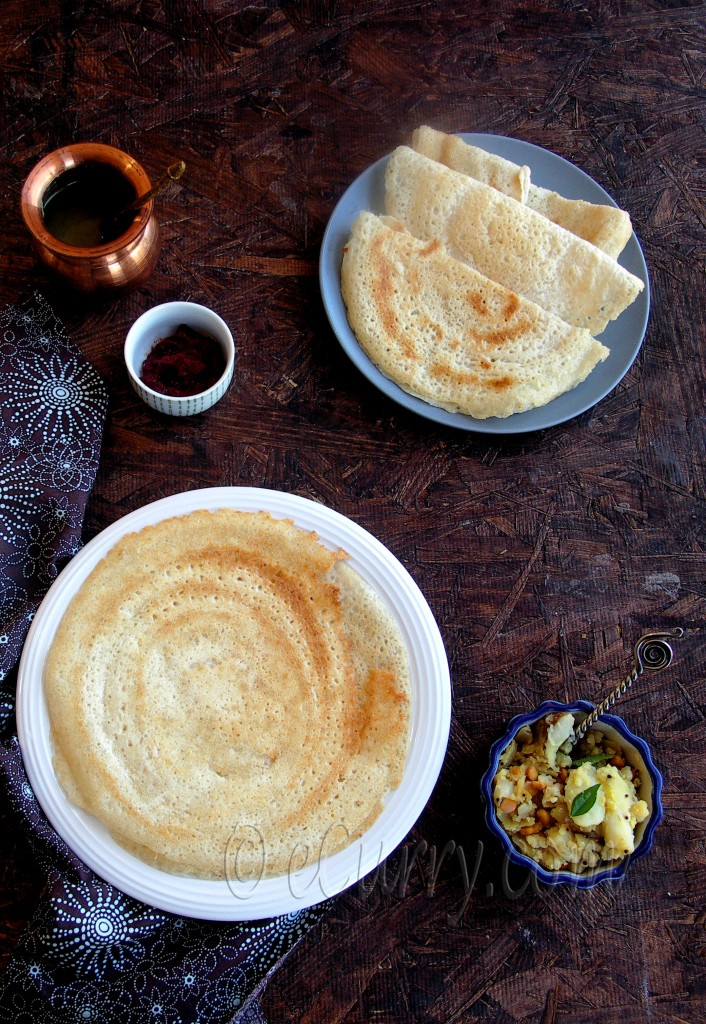
I am sure the memories, experiences, and kinds of Dosa would be very very different for someone from the southern regions of India who grew up with these being made frequently at home. The large stone grinder that is traditionally used to grind the rice and the lentils was something I encountered with amazement and fascination in our friend’s home. The dark and heavy skillet, they told us was handed down from one generation to another – well seasoned and experienced and probably with a lot of stories to tell.
I have learned to make this basic Dosa by closely watching my ma, one of my close friends and also A’s brother in law, who is an excellent and a natural cook. I have perfected the art ( at least to make it the way we all love it at home) over the years, but I do owe it a lot to these three people in my life.
To all those who are experts in making Dosa and have more experience than me, I am open to suggestions and tips on this, to make it better or for any changes that might be needed. Please “say” in the comments and I am sure it will help me and the others. TIA!
There are many kinds of grains that are used for different varieties of Dosa. But the ones made with a combination of rice and lentils is the one I am most familiar with or at least have been able to master. So the recipe today.
I have been told that the Dosa eaten everyday are not usually as paper thin or crisp (not the “Paper Dosa“). They are soft, delicate, not crisped as much, and can be easily folded, delicious nevertheless. Neither are they always filled with the potato curry or served only with sambar and chutneys as they are sold on the streets.
At home, they are treated more like a flat-bread and served with any kind of side.
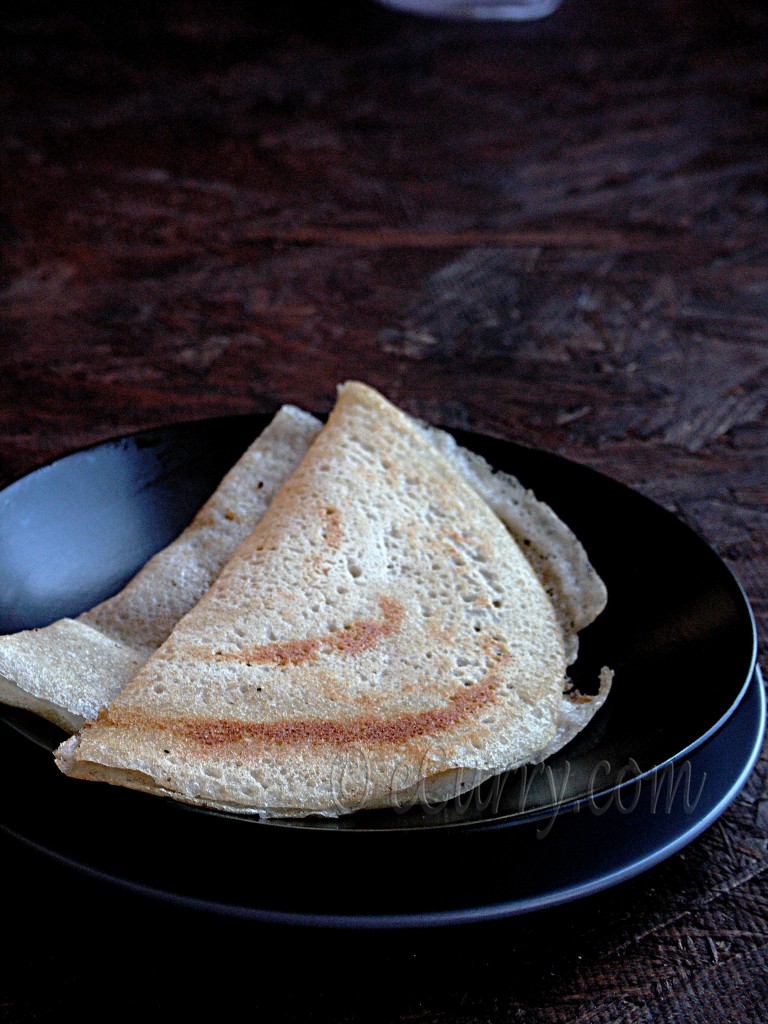
But crispy and thin is how we are used to. The family would have it no other way, even though I will make a whitish soft one for myself.
Here is a collage of the steps (not on the stove, but just to have the basic idea of the process…) – go clockwise.
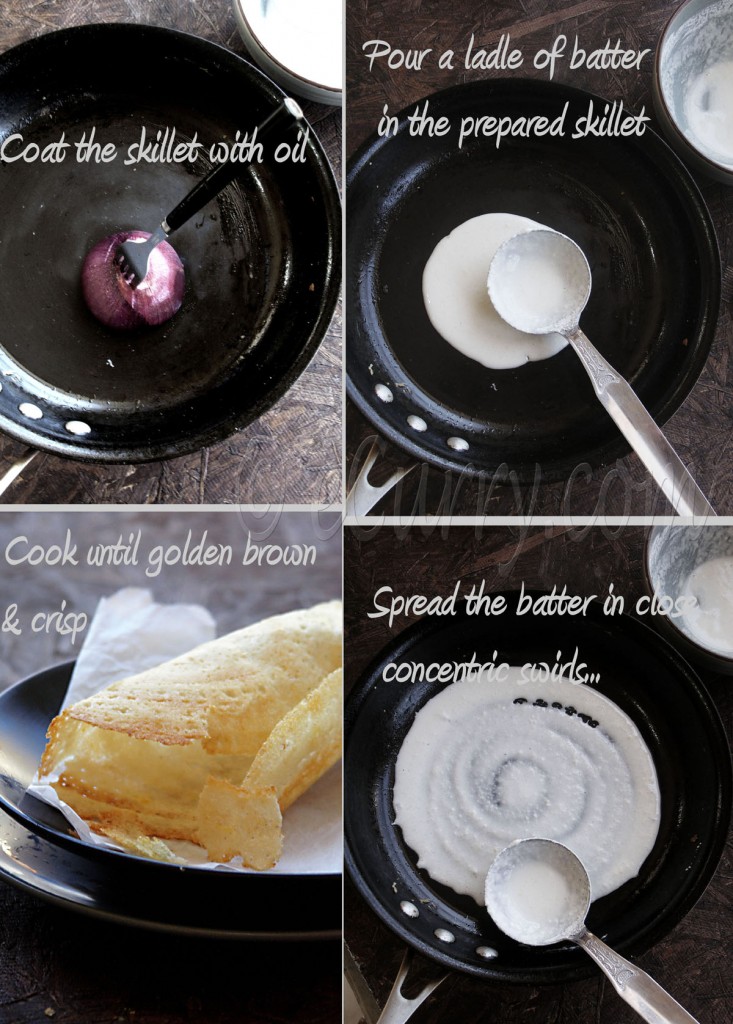
and a video!! – the very first one in this blog.
Now let us head for the recipe. A bit long it might look, but read through it as I have tried to do it as much detailed as possible.
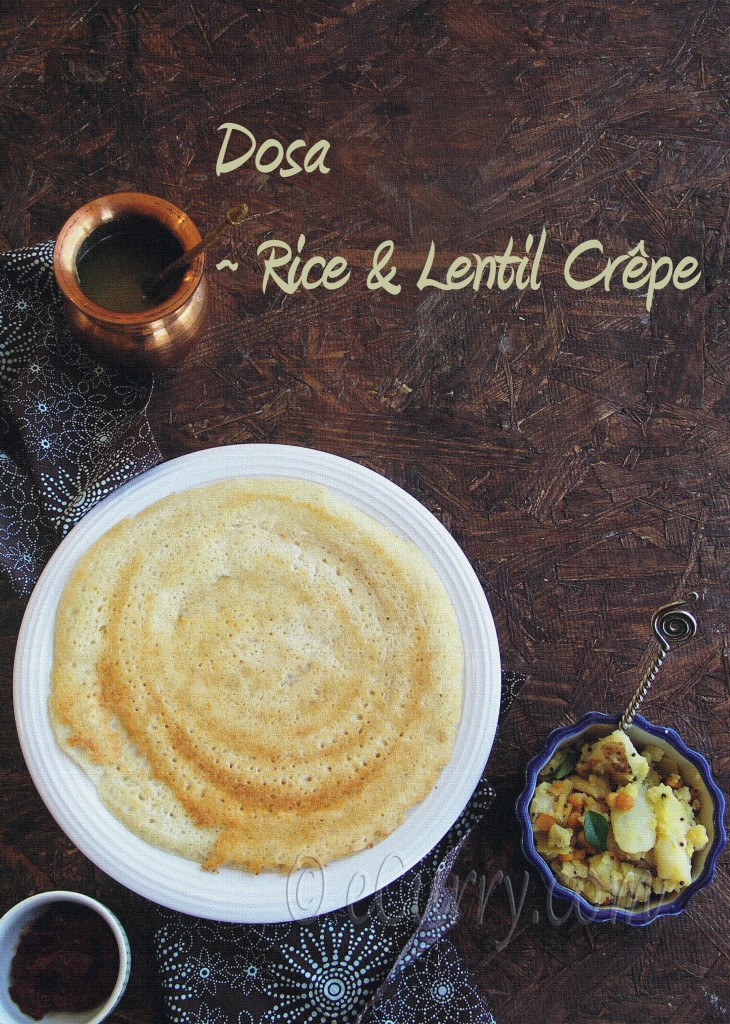
Dosa – Rice and Lentil Crepes
Ingredients: (serves about 10)
- 3.5 cups short – medium grained rice (like sona masoori)*
- 1 cup whole urad dal (husked/skinned but whole black gram)
- 1 & 1/4 teaspoon salt
- 1 – 1.5 teaspoon methi/fenugreek seeds
- 1/2 tablespoon chana dal or chickpea flour/besan (optional) – if you want to make dosa with a brown tinge
* If you do not find the specified rice, go ahead and use basmati rice. I have used it at times, and sometimes the fermentation time differs, but it does still work, even though it is not a traditional kind of rice to use.
Other things you will need:
- oil/ghee to cook the dosa
- 1/4 tablespoon oil + 3/4 cup water (combined)
- 1/2 of a large onion
Method:Notes: This is the basic Dosa recipe. If you want thin crisp Dosa, use less batter and spread it thinner. If you prefer thicker softer one, do not spread it as thin, and lower the heat and cover it while you cook. The steam softens the dosa and prevents it from getting crispy.
This recipe will make plain Dosas. To spice it up, I will spread some chutney (like Tomato Lentil or Roasted Tomato & Bell Pepper) in a thin layer on the top after the drizzle of oil, while it is almost done cooking or sprinkle it with Spiced Powder.
I use my iron skillet or my Calphalon Hard Anodized skillet/griddles to make Dosa. I will use non stick pans sometimes. If you do not have a well seasoned skillet, and it is your first time, use a non-stick skillet.
Preparing for and making the batter:
Wash the rice until water runs clear. Soak the rice in room temperature water. The rice grains should be completely immersed in water and the water level should be about two inches above the rice in the bowl.
Combine urad dal and methi/fenugreek seeds and the chana dal if you are using it. Wash lentils until water runs clear and soak in room temperature water in the same way as you did the rice. The rice and the lentils should soak for at least 6-8 hours or overnight.
Use your blender, food processor or the wet grinder if you own one, to grind the rice. Use the soaking liquid, about a cup to 2 cups to grind the rice into a smooth batter. You might feel the ground grains a bit when you touch it, more like sand/grit/semolina, but that is okay. If you think you need more liquid, add splashes of it, but not too much to make it an extremely runny batter. Remove the ground rice in a large bowl.
Now grind the dal/lentil, in the same blender/grinder/processor, a little at at time to make smooth fluffy mix. Use the soaking liquid to grind the dal. The mix should thick and not too runny. It should thickly coat a spoon and will drip.
Now in a really large bowl (the mix will ferment, get fluffy and rise almost to double or more), combine the ground rice, the ground lentil and salt. Stir using your hands. Please do not skip using your hands to stir; the heat of the hands is a necessary ingredient here for the batter to ferment in the right way. Cover the bowl loosely with a kitchen towel or a loose fitting lid. Do not use an air tight lid, for slight air circulation is required.
Leave the batter in a warm place (about 85 F – 90 F) for about 8 hours or overnight to ferment. If you are in a cooler place, the fermentation process might take longer (sometimes up to 12 hours) or you might need to use your oven to help it ferment. Switch on the light of the oven and leave the bowl in the over for 8-10 hours. Usually the warmth of the light helps. Or pre heat the oven to warm or to 100F. Switch it off and let it stand (oven door closed) for about 20 -30 minutes. Then place the bowl in the oven and close the door and let it stand there for 8 – 10 hours or as long as it takes for it to ferment.
The final fermented batter should be slightly frothy/foamy and airy, and should have almost doubled in volume. The consistency should not be too runny or thin, neither too thick; the kind that pours out of a ladle easily and yet it will not spread too far when poured in a pan. If you feel it is thick, add some water (room temperature).
After the batter is fermented, it may be refrigerated if you are planning to make the dosas later. If you are refrigerating, open the lid and air the batter once a day. Just make sure to bring back the batter to room temperature before you start making the crepes.
If after 10 -12 hours, if you see no signs of fermentation or it has not increased in volume (and it should not happen unless something drastically went wrong), it will not ferment any more, and will start to go bad, if left outside for any longer. Toss it away.
Cooking the Dosa:In a small bowl, combine 3/4 cup water with 1/4 tablespoon oil. Cut the whole onion horizontally and pierce a fork at the uncut end.
Heat a large (about 10 inch) cast iron, or nonstick skillet on high heat.To test if it is hot enough, sprinkle few drops of water on the skillet; if it water sizzles and dries off in a couple of seconds, you know that it is hot just right.
Now reduce the heat to medium. Dip the fork pierced onion in the oil and water mix, just enough to coat the uncut end of the onion and in circular motion/close swirls, wipe or coat the pan. (the temperature of the pan should come down slightly for the batter to spread well).
With a ladle, pour approximately 1/4 cup of batter in the pan. Immediately, starting from the center, spread out the batter while moving the ladle in close concentric swirls. Increase the heat of the stove a tiny bit more now. Drizzle a few drops of oil evenly on the Dosa. Cook until the under side of the Dosa turns golden; you will see the edges slightly curling slightly and releases itself. When you can lift the Dosa off the pan easily with a spatula, the Dosa is done!
If you want it a bit more crispy (my family will want a bits of tiny tough crisped on the other side), you may flip it over and cook the other side for less than a minute; but it is not usually done or required in traditional dosas.
Serve hot. If you want crispy Dosa, serve immediately as it is cooked. I usually cook the Dosa one at a time, while I have family/guests seated at the table dining. Each one gets their share straight from the griddle.
If you do not care for the crispy ones, the Dosas may be made ahead and stacked and covered to keep warm. I almost never do this, and would recommend to serve hot if possible.
To serve with filling, fold the dosa into half, or roll it up or fill in with a dry potato curry for Masala Dosa – (dosa stuffed with lightly tempered potato curry). Serve with Chutney and Sambar.
Preparation Time: 30 minutes – 45 minutesStanding Time: Including Soaking Rice and Lentils & then Fermenting the batter: 10 – 18 hours
Cooking Time: 2-2.5 minutes for each Dosa
Serves: 10 for a meal
Related Posts:
Lachha Paratha – Layered Griddle Cooked Flatbread
Patishapta – Crêpes with Sweet Coconut Cardamom Filling
Naan
Poori – Deep Fried Puffed Bread
Aloo Parantha – Potato Stuffed Flatbread
Garlic Chard Roti/Flatbread
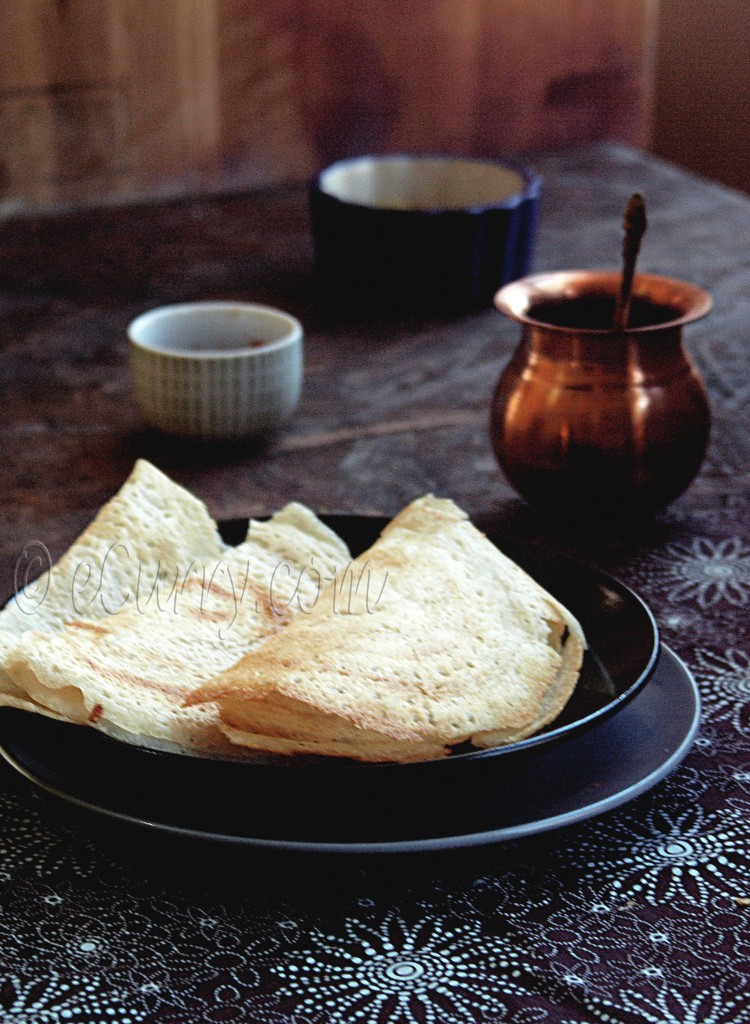
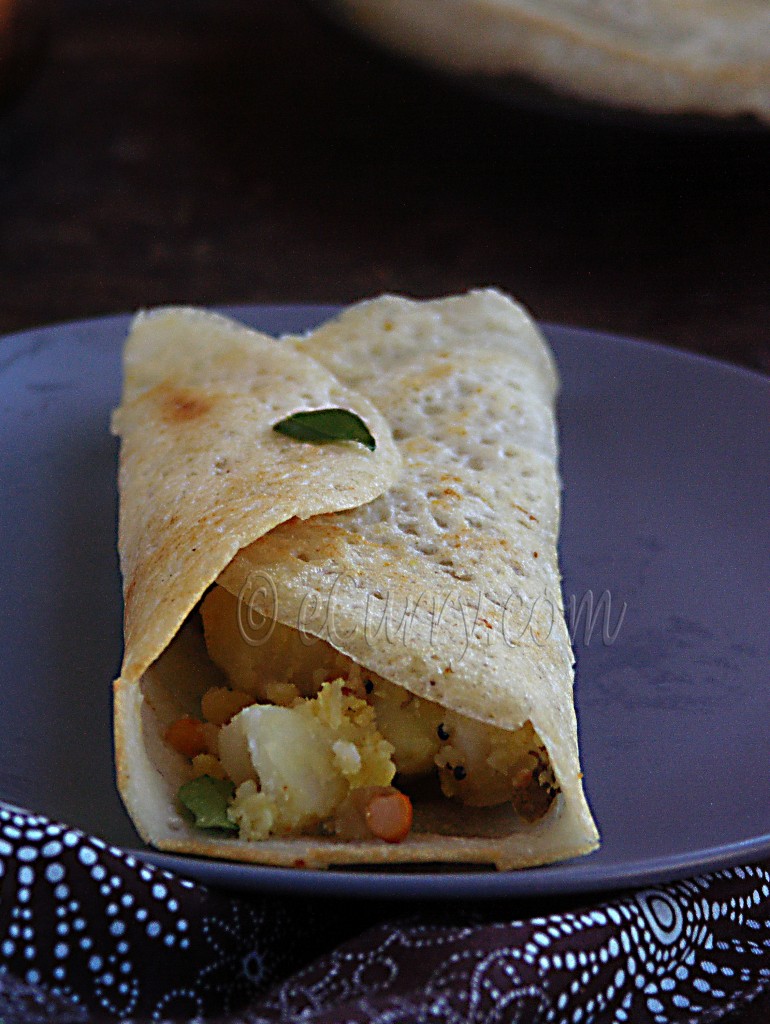

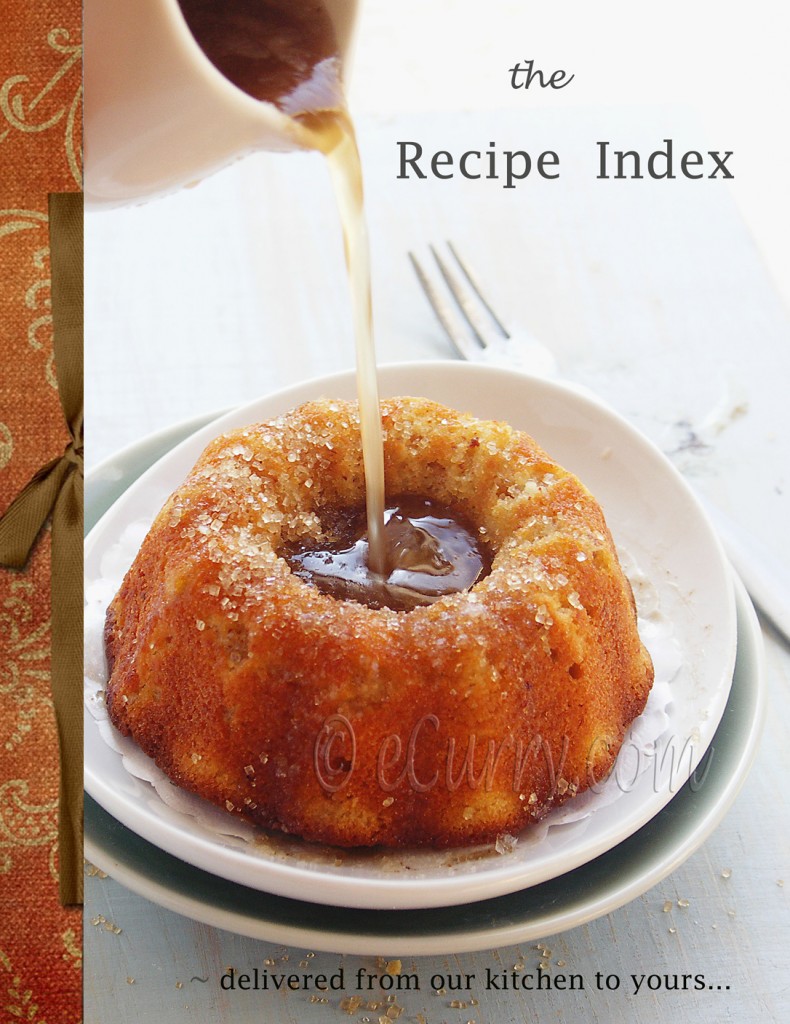
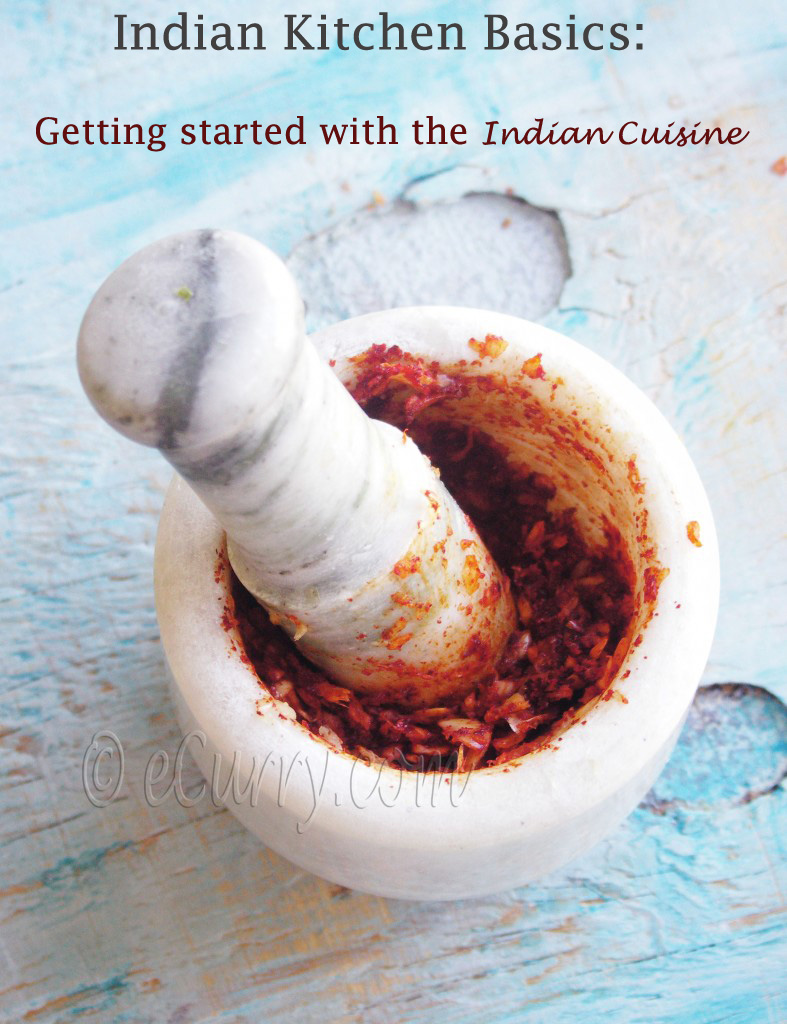
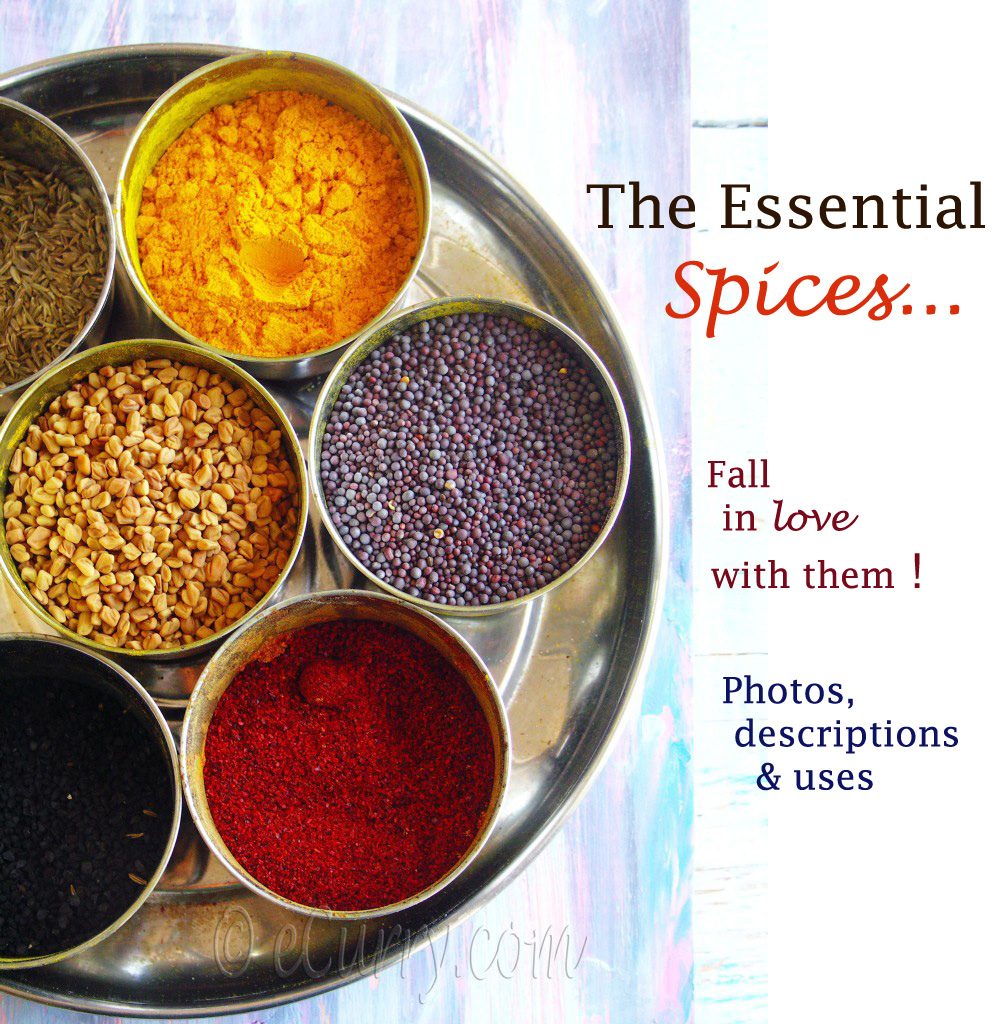








Looks perfect Soma! As you said its one of the staple dish in South Indian homes. You have made it so well and do you use the same batter for making idlies?
Wow! Those are truly really thin, but look so lovely! I’d really love to try this out 🙂 Hopefully I won’t tear them!
Looks perfect.. thin and crispy. Even the video is good, as you said very helpful for first timers.
They look absolutely delicious! A delightful speciality. The texture is perfect.
Cheers,
Rosa
Sona masoori!! lol Not to mention topi dosa and and tunnel. You crack me up and love the video. You did a fine job! I can tell by the way you move with the spatula that you are an excellent eperienced cook. Enjoyed this post very much Soma!
So thin and delicate! I need to make these.
Soma my lovely friend what a gorgeous post…I am in awe of your dosas and my mouth is watering! I have been craving dosas and after seeing your beautiful post I want some right NOW! I so wish you were my neighbor! Thank you for the video, its extremely helpful!
Wow, these look so good and if I copy exactly, maybe I’ll get something that looks nearly as good. Can’t wait to try it.
The dosas look lovely. However, it’s traditional to make them with par-boiled rice, not regular short-grained rice. It’s usually labeled Idli rice, made from a varietal known as “Ponni”. It is available in most Indian markets in the US, so if you can find sona masoori chances are you’ll find idli rice as well. Better for your health too!
Some childhood memories are more crisp and clear. Specially those which makes us smile and we wish to relive it .. if given a chance. I love your writing so much. You took me there with you Soma 🙂
Now I am going to soak some rice and daal. It’s been so long since I made Dosa.
video ta miss korlum ki kore jani nah. Mene gechi tomake .. ek haate khunti and ek haate camera !!! 😀 😀
:)) oh my god, the dosa carts! you reminded me of so much – the street in the early evening, the sound of his khunti hitting the pan as he went along. the dosa man was second in polularity only to the puchkawala.
and you’ve also done me a massive favour with his post. i needed the whole dosa process briken down into bite size pieces. the video just brings it home! thanks soma 🙂
Great video — I usually use the swirling technique to achieve a thin dosa. I had breakfast, but I am hungry again 🙂
Your dosa looks absolutely gorgeous! I have always wanted to try make it but don’t even know how to go about getting all the ingredients! Hopefully I find a store that carries them soon !
[…] Dosa – Rice and Lentil Crepes […]
Luved the pics,l.li am craving for dose now
Now I have a craving! And off I go to wash rice and urad…
bellissime queste crèpes!! le faccio senz’altro, le ho mangiate la scorsa settimana nel Kerala. Un abbraccio
Nice pics, bad food though! too thin – these will poke the palate.. not enough body, too dry! these are definitely not the South Indian break fast staples… ours are light, airy, crisp at the edge, plumper in the midde, glisteningly moist yummy morsels! 😉 sorry soma, best if you leave this ti people with more experience,.. good post for our american and north indian readers i guess!
Sorry to disappoint you. However if you read through the post carefully, I did mention that the original south Indian Dosa is not served this crisp, but are more as you say. This is the kind they are sold as the street food in the North and even in South Indian restaurants.. crisp and yes pokey sometimes and a lot of us like it that way. If the street food sells plump, softer dosas, it won’t sell, at least in the north. Even the vendor (and he was from the Southern parts of India) served Dosa which were so crisp that they would break with a tap. (This is the kind of dosa we are used to, thin, crispy and seems like it is sold as a street food in the South too! – : http://www.zesterdaily.com/cooking/1316-masala-dosa-recipe). I love the typical dosa of the South Indian homes, but no one else in my home will have it. BTW these were not dry at all and I have had sharper dosas served by our very close Tamilian friend. Now if she made those to please us or that is how she usually makes them, I do not know.
I would also like to know what you do different to make your traditional kind in terms of batter (I know the spreading for the dosa would differ and I have seen an elderly lady (again from the South/Mangalore cover her dosas to make them soft, while cooking). The friends we have (from the South) use this exact same kind of batter.
Regards
Soma
Great one to see….Would like to taste it as i am fond of dosa.I am a great fan of ur blog.. I keep trying many things from Dosa – Rice and Lentil Crepes.
Very nice recipe thank you for posting
Love the clicks!! Wanna grab it right now .
I am a South Indian and this is the first that I have read a complete accurate description about making dosa. Just one thing which I wud like 2 add is about the heat of the flat pan or tawa on which we make dosa. It’s plays very imp role on the successful outcome of dosa.
Enjoy dosa x
I would love a recipe for the “dry potato curry” I have made dosas but am struggling to find a recipe for the potatoes.
[…] MILK RICE- Yum Yum YumAuthentic DOSA-RICE AND LENTIL CREPE- E […]